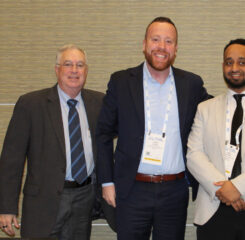An Equal Employment Opportunity Commission (EEOC) final rule and interpretive guidance concerning implementation of the Pregnant Workers Fairness Act (“PWFA” or “Act”) is effective as of June 18.
The PWFA requires employers with 15 or more employees to provide reasonable accommodations for a qualified employee’s (including an application) known limitations related to, affected by, or arising out of pregnancy, childbirth, or related medical conditions, unless the accommodation will cause an undue hardship on the operation of the business of the employer.
The Act itself has been in effect and enforceable since June 27, 2023. In addition to establishing substantive requirements, the Act directed the EEOC to publish a rule providing examples of reasonable accommodations addressing known limitations related to pregnancy, childbirth, or related medical conditions. The final regulations provide these examples, as well as definitions of key terms and other provisions.
Along with the regulatory language, the EEOC has published a detailed Appendix with interpretive guidance on a variety of issues, including employee limitations, employee requests for reasonable accommodation, employer responses to these requests, and undue hardship. The Appendix represents the EEOC’s interpretation of the major provisions of the Act, and the Commission will be guided by the regulation and the Interpretive Guidance when enforcing the statute and regulation. In all, the Appendix includes nearly 80 examples, with accompanying discussion, to reflect the EEOC’s interpretation of the major provisions of the Act and rule.
What employers and employees are covered by the FWPA?
The PWFA applies to private employers and public sector employers (state and local governments) that have 15 or more employees. It also applies to Congress and Federal agencies, and to employment agencies and labor organizations.
The protections of the law apply to “qualified” employees and applicants. An employee or applicant can be “qualified” under the PWFA in two ways.
First, it means an employee or applicant who, with or without reasonable accommodation, can perform the essential functions of the employment position. This EEOC summary offers an example: “Many employees or applicants seeking accommodations will meet this part of the definition because they can perform the job or apply for the position with a reasonable accommodation—for example, the cashier who needs a stool, the production worker who needs bathroom breaks, or the retail worker who needs to carry around a bottle of water.”
Second, even if an employee or applicant cannot perform the essential functions of the job with or without a reasonable accommodation, an employee or applicant will be considered qualified if— (A) any inability to perform an essential function is for a temporary period; (B) the essential function could be performed in the near future; and (C) the inability to perform the essential function can be reasonably accommodated. The EEOC summary provides an illustration: “This means that an employee who is temporarily unable to perform one or more essential functions of their job, and who therefore needs light duty or a change in their work assignments, may be able to get such a change as a reasonable accommodation.” The full analysis of reasonable accommodation would be conducted, of course.
What Does the PWFA Require?
Reasonable Accommodations
The FWPA requires covered employers to make reasonable accommodations to the known limitations related to the pregnancy, childbirth, or related medical conditions of a qualified employee, unless the employer can demonstrate that the accommodation would impose an undue hardship on the operation of its business.
A “known limitation” means a physical or mental condition related to, affected by, or arising out of pregnancy, childbirth, or related medical conditions that the employee or the employee’s representative has communicated to the employer, whether or not such condition meets the definition of disability specified in section 3 of the Americans with Disabilities Act of 1990 (the “ADA”).
Concerning a “limitation,” the final regulation states that “physical or mental condition’’ is an impediment or problem that may be modest, minor, and/or episodic and clarifies that the limitation must be a condition of the specific employee in question and not a family member. “Known,” in terms of limitation, means the employee or the employee’s representative has communicated the limitation to the employer. The regulation explains that the communication informing the covered entity of the limitation does not need to be in writing, be in a specific format, use specific words, or be on a specific form in order for it to be considered communicated to the employer.
The terms “reasonable accommodation” and “undue hardship” have the meanings that are given to these terms under the Americans with Disabilities Act of 1990 (ADA), and they will be construed for purposes of the PWFA in the same way as these terms are construed under the ADA, including with regard to the interactive process used to determine an appropriate accommodation.
While the PWFA uses terms and definitions from the ADA, the PWFA differs from the ADA in significant ways, and analysis of both laws will be important. For example, a physical or mental condition can be a known “limitation” under the PWFA – triggering an employer obligation, absent undue hardship – whether or not such condition meets the definition of disability specified in the ADA. Also, in order to be protected by the ADA, an individual with a disability must be qualified to perform the essential functions of the job with or without reasonable accommodation. However, the second part of the definition of “qualified employee,” noted above, creates an exception to the first part and, as a result, the PWFA goes beyond the ADA. Depending on the facts and circumstances, an employee may be entitled to an accommodation, absent undue hardship, under the PWFA only or under both laws.
For purposes of the PWFA, the EEOC’s final regulatory language and interpretive guidance include examples of what reasonable accommodation may include, such as part-time or modified work schedules, breaks for use of the restroom, drinking, eating, and/or resting; acquisition or modification of equipment, uniforms, or devices, including devices that assist with lifting or carrying for jobs that involve lifting or carrying, providing seating for jobs that require standing, and permitting the use of paid leave or providing unpaid leave. As noted below, employers may not require qualified employees to take paid or unpaid leave if another reasonable accommodation can be provided without undue hardship.
Other Requirements: Prohibited Practices
In addition to stating that an employer must make a reasonable accommodation to the known limitations of a qualified employee (unless the accommodation would cause an undue hardship), the PWFA specifies that covered employers must not:
- Fail to make a reasonable accommodation for the known limitations of an employee or applicant, unless the accommodation would cause an undue hardship;
- Require an employee to accept an accommodation other than a reasonable accommodation arrived at through the interactive process;
- Deny a job or other employment opportunities to a qualified employee or applicant based on the person’s need for a reasonable accommodation;
- Require an employee to take leave if another reasonable accommodation can be provided that would let the employee keep working;
- Punish or retaliate against an employee or applicant for requesting or using a reasonable accommodation for a known limitation under the PWFA, reporting or opposing unlawful discrimination under the PWFA, or participating in a PWFA proceeding (such as an investigation);
- Coerce individuals who are exercising their rights or helping others exercise their rights under the PWFA.
Interplay with State Laws
Various states have enacted their own laws concerning accommodation of restrictions resulting from pregnancy, taking a variety of approaches, and some local governments may have done the same. Employers should continue to consider these accommodation laws. The PWFA establishes a federal minimum, but it does not invalidate or limit such laws that provide greater or equal protection for individuals affected by pregnancy, childbirth, or related medical conditions.
Additional Information is Available
Employers are advised to review and update accommodation policies to comply with the PWFA and train personnel involved in evaluating accommodation requests.
The EEOC has posted several resources, including frequently asked questions, an overview webinar for employers, information for employees requesting reasonable accommodations, as well as informational posters employers may utilize. Visit these links to access this information and more:

 Shutdown Week Three: Impact of Ongoing Closure on Affordable Housing
Shutdown Week Three: Impact of Ongoing Closure on Affordable Housing Colleagues on the Move, December 17, 2025
Colleagues on the Move, December 17, 2025


